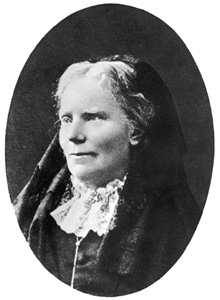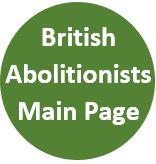Elizabeth Blackwell (1821-1910)
By Barb Drummond

Biography
Young ladies all, of every climeBetter known as an American doctor, Elizabeth Blackwell was in fact British-born and a life-long opponent of slavery. Blackwell was described as 'a guiding star… to rebellious women everywhere', but she was less motivated by ideas of rebellion than a desire to provide women's health care without embarrassment to them. She was America's first registered female doctor and the first woman on the British medical register. Her sister Emily and two nieces later became doctors; her sister in law was Lucy Stone, pioneer of women's rights and Antoinette Brown Blackwell who was the first female ordained minister, so she was part of a family of determined women and men. Family friends included abolitionist William Lloyd Garrison, Florence Nightingale, Mary Carpenter, Lady Byron, Dante Gabriel Rossetti, Harriet Beecher Stowe, Charles Kingsley, and Julia Ward Howe who wrote 'The Battle Hymn of the Republic'.
Especially of Britain
Who wholly occupy your time
In novels or in knittin'
Whose highest skill is but to play
Sing, dance, or French to clack well,
Reflect on the example, pray
Of excellent Miss Blackwell!
—— Punch, 1849
Elizabeth was born in Bristol in 1821, by which time abolition had shifted from being a single issue campaign to part of the wider and more complicated arena of human rights and the English Enlightenment. Her parents provided their daughters with the same education as their sons, and inspired them all with notions that they had a duty to reform society. Father Samuel was a sugar refiner and abolitionist, one of the founders of the Bristol Abolition Society. He was also a deacon at the Bridge St Chapel where the children heard tales of missionaries returning from Africa with tales of sacrifice and adventure at the annual conference.
Following the Bristol Riots of 1831 (one of the biggest civil disturbances of the nineteenth century) Samuel moved the family to New York, believing they would have a better future there, even though the city was a major centre for financing slave vessels. He became involved in the abolitionist movement and they hid a runaway slave for several weeks before he set off for Canada. When Samuel died, the daughters were forced to take up teaching and for a time Elizabeth worked in Kentucky, but left in disgust at the slavery system.
She struggled to gain entry to a medical school, but after extensive private tuition was accepted – apparently as a joke by the students – by Geneva Medical School of Western New York, where she graduated top of her class. But then she had trouble obtaining work so, in 1853, she opened a dispensary for the poor in New York's slums. With the outbreak of the Civil War, she trained nurses for the Union Army, which had none at the time. Following the Emancipation Proclamation of September 1862, many whites feared freed slaves would take their jobs, and riots broke out in New York City in July 1863. Buildings close to the infirmary were burnt down and white patients demanded the discharge of several black expectant mothers, but the doctors refused. After the war she opened the Women's Medical College at the Infirmary in 1868. One of its graduates was Rebecca Cole, the first black woman to become a doctor.
In 1869, Blackwell returned to England and attended the annual meeting of the National Association for the Promotion of Social Science in Bristol when the nation's great and good debated important matters. The Times reported her contributions on women in medicine and her opposition to the death penalty for infanticide. Local papers seem not to have noticed the various women attending. With Mary Carpenter she was also an opponent of the Contagious Diseases Acts which subjected women suspected of prostitution to compulsory examination, while men went free. She also helped found, in 1871, the National Health Society aimed at preventing ill health by education on health and hygiene; it continued till superseded by the National Health Service. In addition, she campaigned against vivisection, for municipal reform co-op communities, the Garden City movement, prison reform, and technical education for women, all of which were radical in their day, but were just part of the idealism of the family she was born into. She died in 1910 by which time The United States had 7,000 women doctors.
Her colleague Dr Maria Zakrzewska wrote of her 'she was the leader of the movement; because she had the energy, will and talent [...] and because she is a landmark of the era of women's freeing themselves from the bondage of prejudice and from the belief that they are the lower being when compared with men. We cannot afford to forget her.' [cited in Agnes C. Vietor, A Woman's Quest, The Life of Marie E. Zakrzewska, M.D. (New York: D Appleton & Co, 1924)].
Text © Barb Drummond, 2007
E-mail: curioushistorian@outlook.com
Bibliography
Selected Secondary Works
Links
The Contributor
Barb Drummond is a local historian from Bristol, England, who writes, does photography, gives talks and leads walks in the city.
Her website is at https://barbdrummondcurioushistorian.com/



